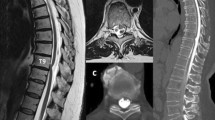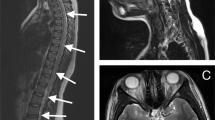Abstract
Spinal cord herniation (SCH) is a rare condition associated with tethering of the spinal cord at the ventral dural defect. Idiopathic dorsal spinal cord herniation (IDSCH) is an extremely rare clinical entity. Here, we report the first case of IDSCH perforating the lamina in a patient with a history of ossification of the ligamentum flavum and diffuse idiopathic skeletal hyperostosis. Untethering of the spinal cord was performed by removing the surrounded ossified dura. Although urological symptoms and impaired proprioception remained, progressive neurological deterioration was prevented. Because this disease condition is extremely rare, it should be differentiated from ventral SCH.





Similar content being viewed by others
References
Heller RS, Hwang SW, Riesenburger RI (2017) Dorsal cervical spinal cord herniation precipitated by kyphosis deformity correction for spinal cord tethering. World Neurosurg 100:709 e1–709.e4
Ju JH, Kim SJ, Kim KH, Ryu DS, Park JY, Chin DK, Kim KS, Cho YE, Kuh SU (2018) Clinical relation among dural adhesion, dural ossification, and dural laceration in the removal of ossification of the ligamentum flavum. Spine J 18(5):747–754
Kawaguchi Y, Nakano M, Yasuda T et al (2013) Ossification of the posterior longitudinal ligament in not only the cervical spine, but also other spinal regions. Spine. 38(23):E1477–82
Le TC, Grunch BH, Karikari IO, Mehta AI, Owens TR, Gottfried ON, Bagley CA (2012) Dorsal thoracic spinal cord herniation: report of an unusual case and review of the literature. Spine J 12(10):e9–12
Li B, Qiu G, Zhao Y (2016) A potential method for identifying dural ossification by measuring the degree of spinal stenosis in thoracic ossification of ligamentum flavum. Med Hypotheses 96:9–10
Makino T, Takenaka S, Okamura G, Sakai Y, Yoshikawa H, Kaito T (2020) Dorsal spinal cord herniation at the thoracolumbar junction presenting with scalloping of ossification of the ligamentum flavum: case report. J Neurosurg Spine 32:56–60
Matsumoto M, Chiba K, Toyama Y et al (2008) Surgical results and related factors for ossification of posterior longitudinal ligament of the thoracic spine a multi-institutional retrospective study. Spine. 33(9):1034–1041
Miyake S, Tamaki N, Nagashima T et al (1998) Idiopathic spinal cord herniation. Report of two cases and review of the literature. J Neurosurg 88:331–335
Mori K, Kasahara T, Mimura T, Nishizawa K, Murakami Y, Matsusue Y, Imai S (2013) Prevalence, distribution, and morphology of thoracic ossification of the yellow ligament in Japanese: results of CT-based cross-sectional study. Spine. 38(19):E1216–E1222
Nakamura M, Fujiyoshi K, Tsuji O et al (2011) Long-term surgical outcomes of idiopathic spinal cord herniation. J Orthop Sci 16:347–351
Okada E, Yoshii T, Yamada T et al (2019) Spinal fractures in patients with diffuse idiopathic skeletal hyperostosis: a nationwide multi-institution survey. J Orthop Sci 24(4):601–606
Shin JH, Krishnaney AA (2010) Idiopathic ventral spinal cord herniation: a rare presentation of tethered cord. Neurosurg Focus 29:E10
Watanabe M, Chiba K, Matsumoto M et al (2001) Surgical management of idiopathic spinal cord herniation: a review of nine cases treated by the enlargement of the dural defect. J Neurosurg 95:169–172
Watters MR, Stears JC, Osborn AG et al (1998) Transdural spinal cord herniation: imaging and clinical spectra. AJNR Am J Neuroradiol 19:1337–1344
Wortzman G, Tasker RR, Rewcastle NB et al (1974) Spontaneous incarcerated herniation of the spinal cord into a vertebral body: a unique cause of paraplegia. J Neurosurg 4:631–635
Zakaria R, Ellenbogen JR, Grewal IS, Buxton N (2013) Posterior spinal cord herniation: a novel occurrence following surgery for an intramedullary cyst at the thoracolumbar junction. Eur Spine J 22(Suppl 3):S399–S403
Author information
Authors and Affiliations
Corresponding author
Ethics declarations
Consent for publication
The patient has consented to submission of this case report to the journal.
Conflict of interest
The authors declare no competing interests.
Additional information
Publisher’s note
Springer Nature remains neutral with regard to jurisdictional claims in published maps and institutional affiliations.
This article is part of the Topical Collection on Spine - Other
Rights and permissions
About this article
Cite this article
Funao, H., Nakamura, S., Daimon, K. et al. Idiopathic dorsal spinal cord herniation perforating the lamina: a case report and review of the literature. Acta Neurochir 163, 2313–2318 (2021). https://doi.org/10.1007/s00701-021-04804-4
Received:
Accepted:
Published:
Issue Date:
DOI: https://doi.org/10.1007/s00701-021-04804-4




